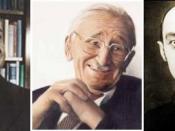Joseph Alois Schumpeter was an economist and a sociologist. He lived during the early 1900's, and had many books published in his lifetime. He was particularly well known for three works: The Theory of Economic Development (1912), Business cycles (1939) and Capitalism, Socialism, and Democracy (1942). He generally wrote from a socialist perspective but did not hesitate to acknowledge the positive aspects of all economic systems.
The Theory of Economic Development stated that entrepreneurs will eventually become obsolete and economic development will become mechanised. At the time of this book's publication it was entrepreneurs who bought about a majority of innovation. Schumpeter thought of innovation as not only technology, but also new processes, goods, markets, sources and organisations. Entrepreneurs bring new knowledge to the economy through experimenting (empirical). This is efficient compared to current rational methods. Rational development is simply using existing knowledge and expanding upon it, and therefore seems rather limited.
Schumpeter sees this problem differently. He believes that with improvements in management techniques and technology, people/computers will soon be able to calculate quickly and almost exactly how to develop. Thus making development a simple rational routine. This will cause socialist economies (where the state owns resources and companies) to be generally as efficient as a capitalist economy (free enterprise is allowed and market forces affect production volume and prices with little government invention). This is due to the fact that socialism is a planned community, which according to Schumpeter is expected to flourish with the new 'mechanical' development techniques.
With innovation becoming a routine thing in the future, all companies would theoretically be able to produce a greater amount of new products. This would move the supply curve for new products to the right. Equilibrium of supply and demand (the demand curve has not moved) would move to...



Good
a well versed and detail essay on the subject.
0 out of 0 people found this comment useful.